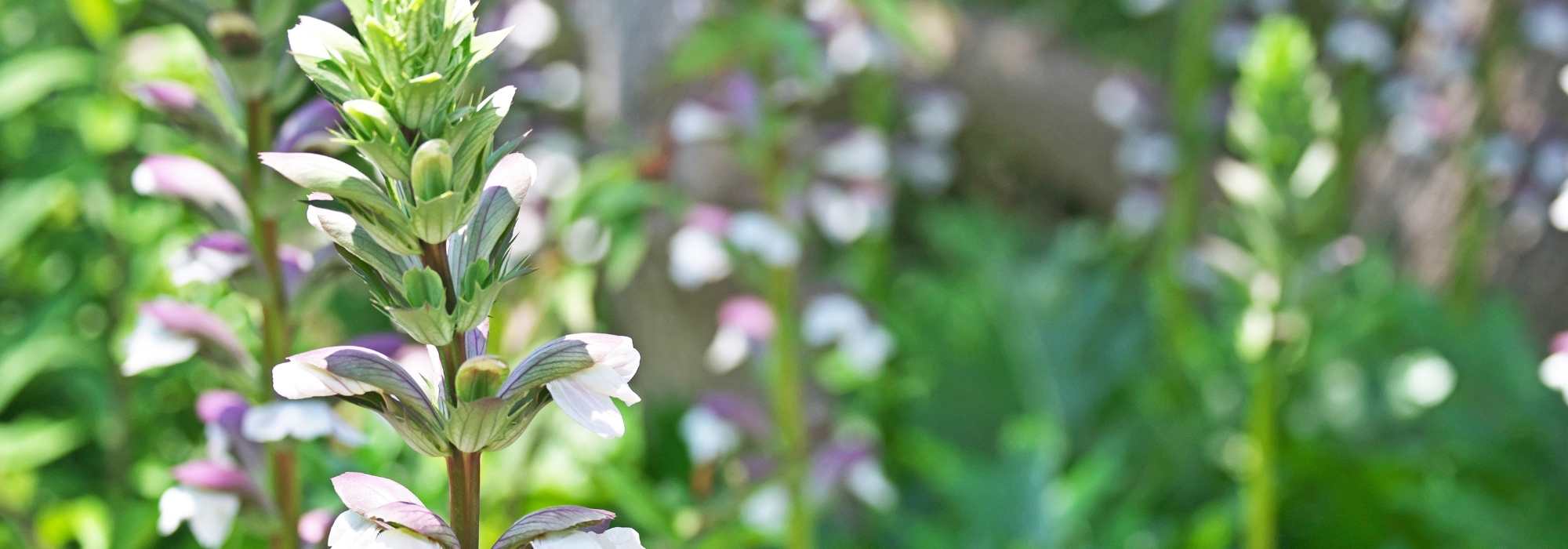
Associating Acanthus : the best companion plants
6 inspirations for your garden
Contents
Sculptural and majestic with its long, seemingly bicoloured floral spikes and superbly cut foliage, Acanthus is a plant that does not go unnoticed. Used since ancient times and an emblem of Corinthian capitals, it fits into many types of gardens, from natural to the more exotic, thriving in both dry and moist soils, and enjoys both sun and light shade. Very hardy, remaining evergreen in mild climates, it produces a sumptuous dark green tuft that gives it all its appeal, even after its spikes have faded. While the Acanthus can be used alone as a focal point, it looks stunning alongside other perennials, ground covers, and bushes. It’s simply a matter of highlighting its graphic silhouette without competing with other plants.
Discover our pairing ideas with Acanthus, a perennial as spectacular as it is dynamic!
Learn more about the Acanthus in our complete guide: Acanthus, plant, grow, and maintain
In an exotic bed
With its large, deeply lobed leaves, Acanthus is a true source of inspiration in the design of an exotic border: its ample, glossy foliage truly shines among exuberant plants. The white inflorescences borne on a tall, rigid spike are among the most original, featuring a very soft bicolour mauve hue provided by the dentate upper bracts. Acanthus thus displays a strong character that perfectly complements the appearance of other exotic plants.
The highly notched foliage of Acanthus (referred to as palmatisect leaves) pairs well with lower, round or smooth, even ribbon-like foliage for contrast, and the erect aspect of the flower responds to other atypical flowerings without overshadowing them: a few tufts of Eucomis in purplish tones or the white spathes of Arums particularly highlight them. A beautiful clump of Alstroemeria brings an essential warm hue to an exotic border, with its linear foliage standing out, such as that of Indian Summer with its bronze colour.
In terms of foliage, a few rounded, variegated Farfugiums will beautifully contrast with the cut of Acanthus leaves in a semi-shaded position. You could add a single, slightly taller bush, such as a Fatsia japonica or a tree fern. Some Hakonechloa macra in a softer green will awaken the dark green of Acanthus.
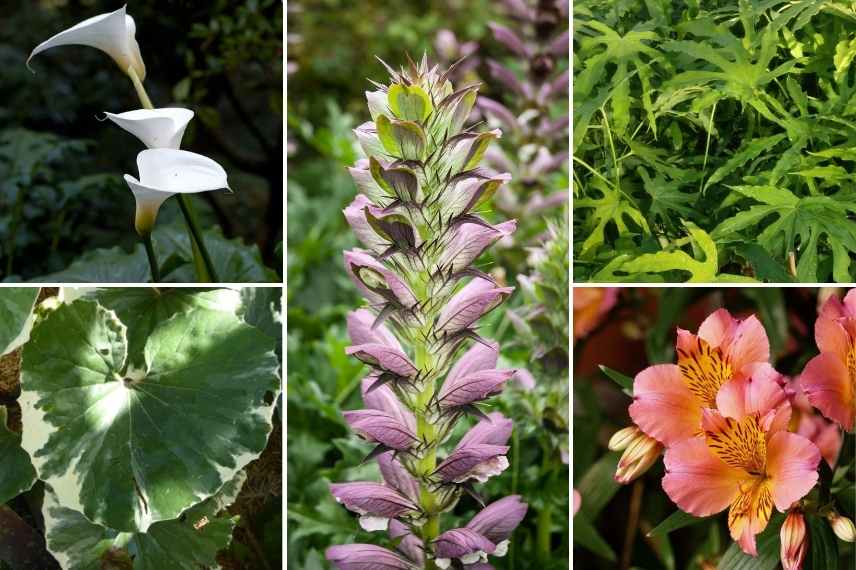
Zantedeschia aethiopica, Farfugium ‘Argenteum’, Fatsia ‘Green Fingers’, Alstroemeria ‘Inca Coral’
In a foliage bed
The generous dimensions of Acanthus and its spectacular foliage make it ideal for a bed where foliage plays a prominent role. For this use, it is important to ensure that the shapes of the foliage do not clash but rather differ to highlight those of the Acanthus, and to play with different volumes. For example, you can associate Acanthus mollis with the lovely small purple-veined leaves of Epimedium versicolor ‘Sulphureum’, which will serve as ground cover, the broad leaves of Hostas chosen in lighter shades like the soft green of Hosta ‘Honeybells’ or Hosta fortunei ‘Twilight’, or the blue of Hosta ‘True Blue’, and the superb palmate foliage of Rodgersia Aesculifolia ‘Irish Bronze’. The rounded evergreen leaves of Asarum europaeum will also bring a lovely presence throughout the year.
In cold climates, where the foliage of the Acanthus will completely disappear, it is wise to install structural and evergreen plants such as Pittosporum heterophyllum, Aucuba japonica ‘Crotonifolia’, which should be kept pruned to a reasonable size and will bring brightness, a Nandina domestica whose slender foliage will create a beautiful contrast, a Mahonia that will echo the spiky nature of the Acanthus, or even a Fatsia japonica, or a Phormium or a Dasylirion in sunnier spots.
Incorporate some touches of ornamental purple foliage with a Pseudopanax lessonii ‘Dark Star’, a Cotinus coggyria ‘Royal Purple’, or a Loropetalum. Cimicifugas simplex ‘Brunette’ with its purple-brown leaves and long white spikes will nicely complement a large bed.
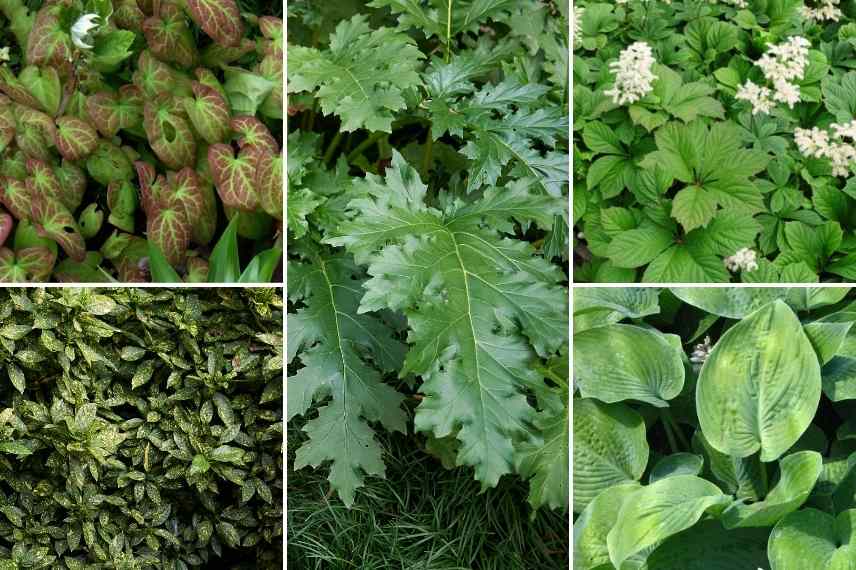
Acanthus accompanied by remarkable foliage: Epimedium versicolor ‘Sulphureum’, Aucuba japonica, Rodgersia ‘Irish Bronze’ and Hosta ‘True Blue ‘
Discover other Acanthus
View all →Available in 3 sizes
Available in 1 sizes

Available in 3 sizes
Available in 1 sizes
Available in 1 sizes
Available in 1 sizes
Available in 1 sizes
Available in 1 sizes
Available in 1 sizes
Available in 2 sizes
In a natural garden
Really versatile, Acanthus graces the spontaneous meadow with much charm. It thrives well in full sun and dry soil. When paired with wildflowers, it willingly lends itself to very natural settings, becoming a totemic plant alongside tall grasses like Pennisetum orientale and wild herbs like Stipa. It is advisable to choose perennials with a very soft and light habit to create a small, very natural plant tangle: Achilleas, Lychnis coronaria, Abyssinian Gladiolus, Astrantias, Cosmos, Valerian, Lysimachia, Persicaria, etc.

A very natural scene featuring Acanthus accompanied by Achillea millefolium ‘Paprika’, Gladiolus callianthus, Pennisetum orientale ‘Tall Tails’ and Cornflowers
In a shady border
Seeming equally at home in sun or shade, Acanthus can easily thrive in a shaded border (provided the shade isn’t too dense, as this would significantly reduce its flowering). It brings a verticality and volume to these rather dull areas that is particularly interesting. To surround your Acanthus, which will form a clump of about 80cm at ground level, you have plenty of options, always keeping in mind the use of laminae with simpler shapes to avoid overshadowing it and to soften the overall effect. Some hardy geranium ground covers will create a lovely carpet, Hostas will add roundness and lushness, and an Azalea in white tones, such as the stunning Azalea japonica ‘Schneewittchen’, will brighten the area in spring just before the Acanthus begins to flower. Also, consider adding some stinking iris; they create an interesting foliage contrast and bloom simultaneously in soft mauve tones, while a Skimmia will provide volume and a lovely presence throughout the year.
You can also pair this shaded ambiance with some pink tones, such as Hellebores, the magnificent Astrantia major ‘Primadonna’, and a touch of purple to highlight these delicate blooms with Heuchera ‘Plum Pudding’. Some Carex that thrive in shade, like the stunning variegated sedge Carex siderosticha ‘Variegata’, will eventually form a beautiful luminous carpet.
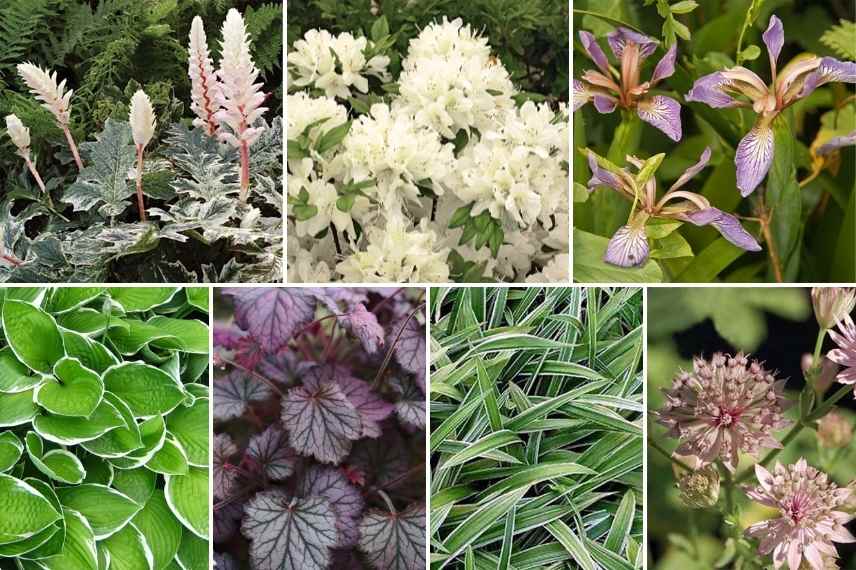
Acanthus ‘Whitewater’ alongside Japanese Azalea ‘Schneewittchen’, stinking iris, Hosta ‘Julia’, purple Heuchera, Carex siderosticha, Astrantia major ‘Primadonna’
In a bicolour or monochrome bed
The mauve flowering of Acanthus pairs beautifully with yellow or a pink to purple plant palette, allowing for the creation of very harmonious or, conversely, dynamic flower beds.
They can thus modernise a yellow mass of Hypericums ‘Hidcote’ or Achillea filipendulina ‘Golden Plate’ in poor soil, or gently blend with the inflorescences of Phlomis fructicosa.
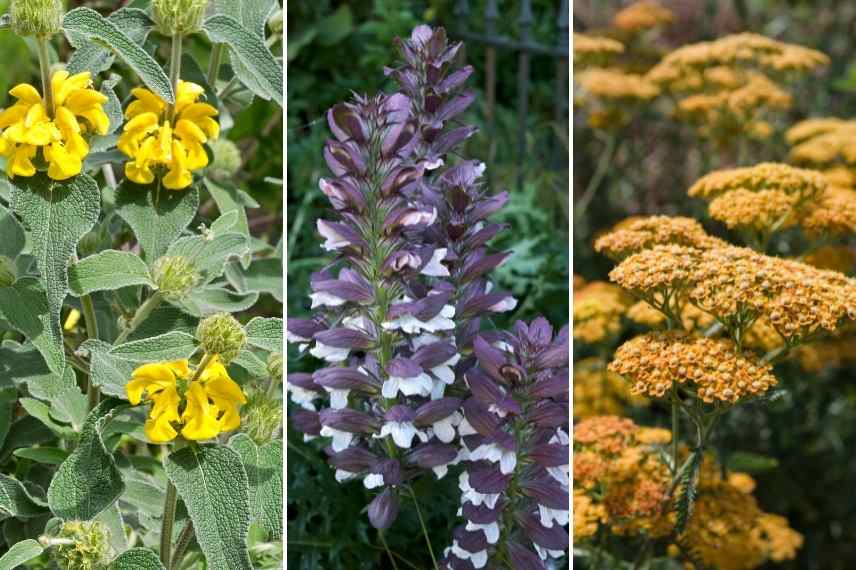 A combination in yellow tones with Jerusalem Sage and Achillea…
A combination in yellow tones with Jerusalem Sage and Achillea…
You can also place them at the back of a flower bed with Iris, Eupatoriums, and Digitalis in cooler soil for a blue and pink scene. You will also create a beautiful scene in blue tones with some Liatris spicata for a graphic duo of upright spike flowers, or with the globes of Agapanthus. The Acanthus-Papaver duo also works wonderfully, contrasting the stature of the Acanthus with the lightness of Oriental poppies.
Finally, white suits Acanthus beautifully. You can imagine numerous combinations for a white garden with shades of pure whites, creams to greenish tones, such as in sunny situations with Alliums ‘Mount Everest’, Phlox maculata ‘Omega’, Hydrangeas arborescens ‘Annabelle’, white Agapanthus, white Gauras, or a slightly aniseed version with Echinacea ‘Green Jewel’.
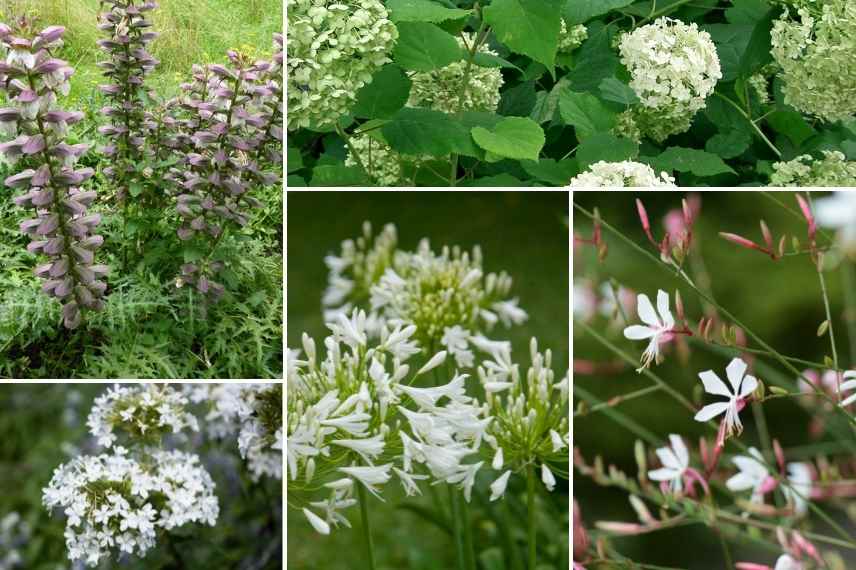 Acanthus spinosus in a white garden with: Hydrangea ‘Annabelle’, Phlox paniculata, Agapanthus, and white Gaura
Acanthus spinosus in a white garden with: Hydrangea ‘Annabelle’, Phlox paniculata, Agapanthus, and white Gaura
In a woodland
Acanthus shines at the edge of the undergrowth, where it finds favourable conditions in terms of soil and exposure: the variety ‘Whitewater’ with its variegated cream foliage will illuminate this area and will easily pair with some Polygonatums gracefully arching with cream bell-shaped flowers. Spotted Foxgloves like Digitalis purpurea, Liriopes, some clumps of Wood Hyacinths and ferns Dryopteris filix ‘Mas’ thriving in this humus-bearing soil will be the perfect companions for the architectural Acanthus.
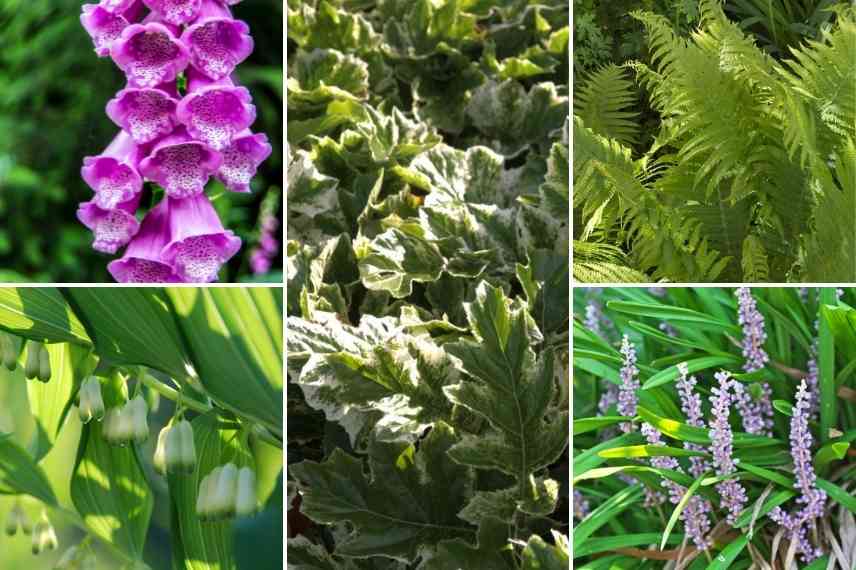
Acanthus ‘Whitewater’ in the centre, paired with Purple Foxgloves, Solomon’s Seal, some filix ‘Mas’ ferns, and Liriope muscari
- Subscribe!
- Contents
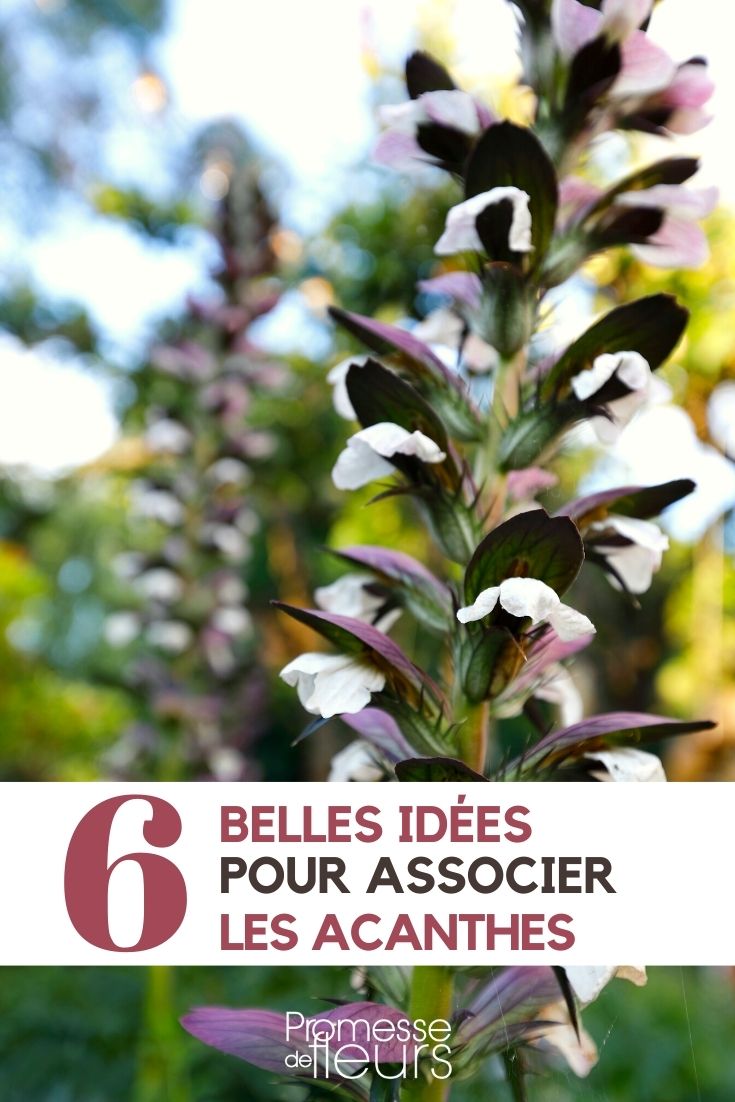































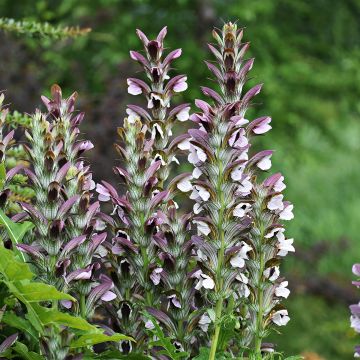
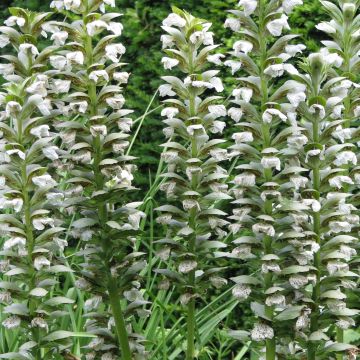
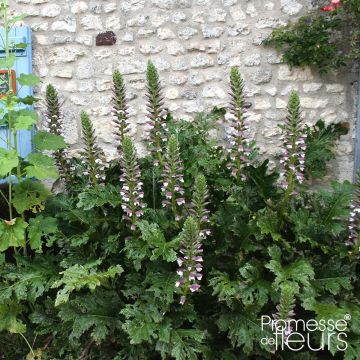
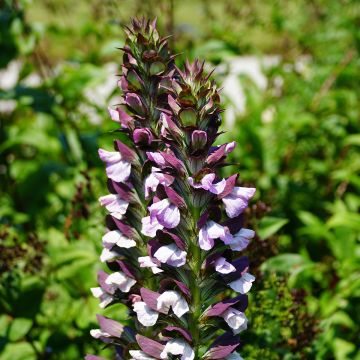
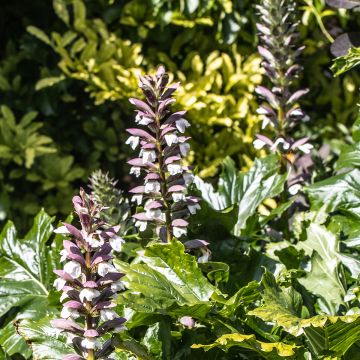
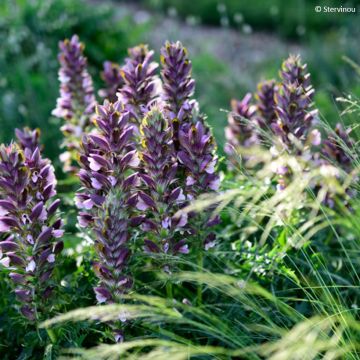
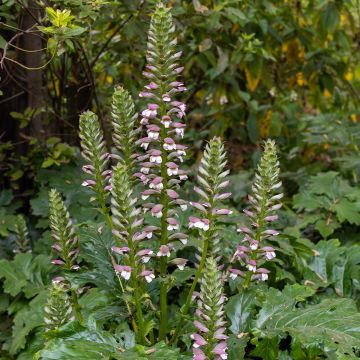
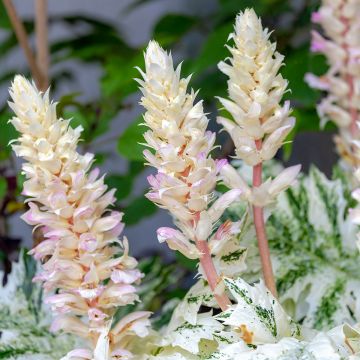
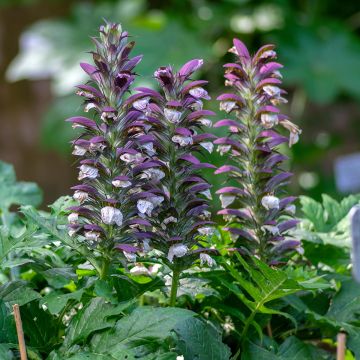
Comments